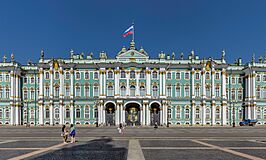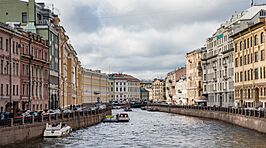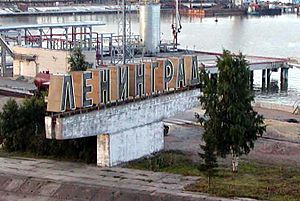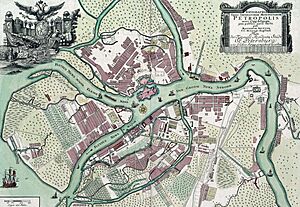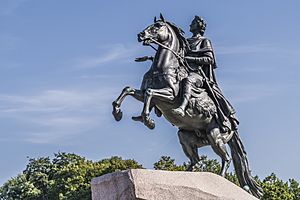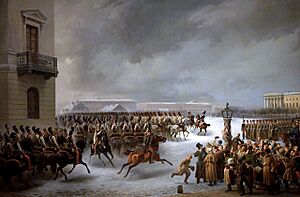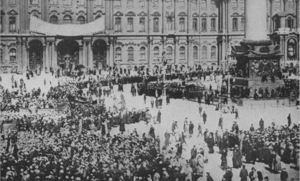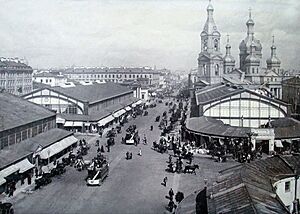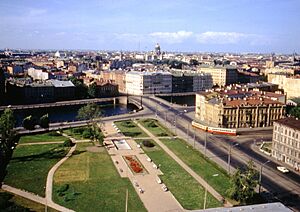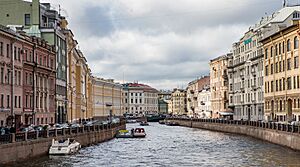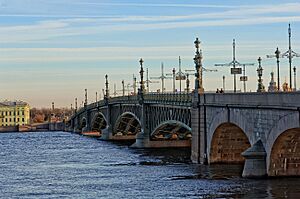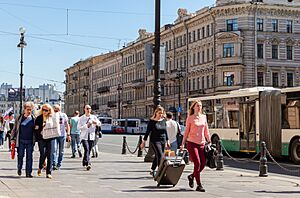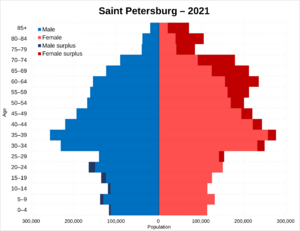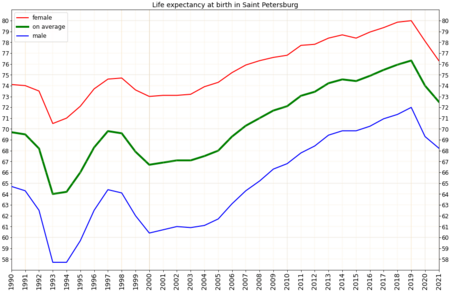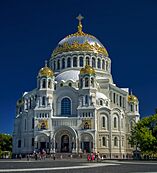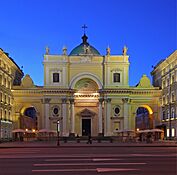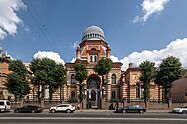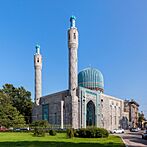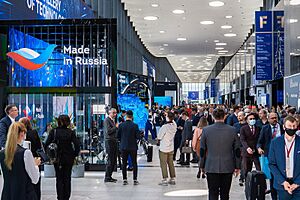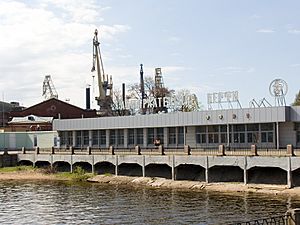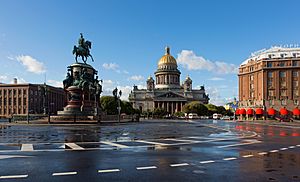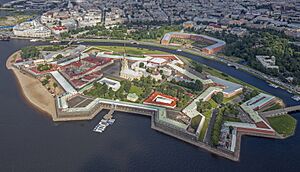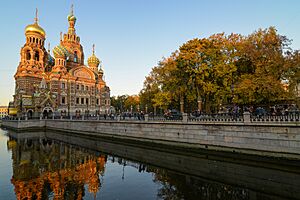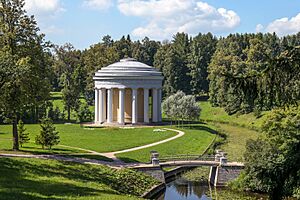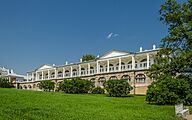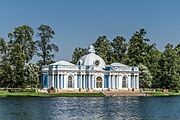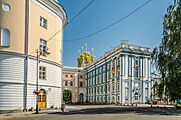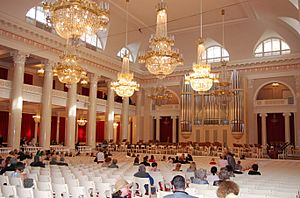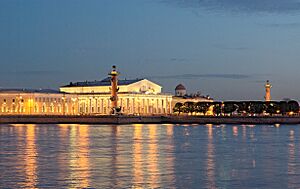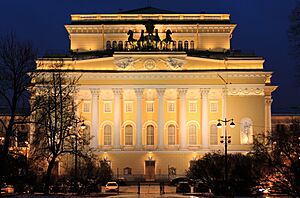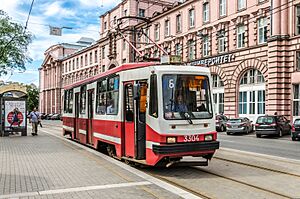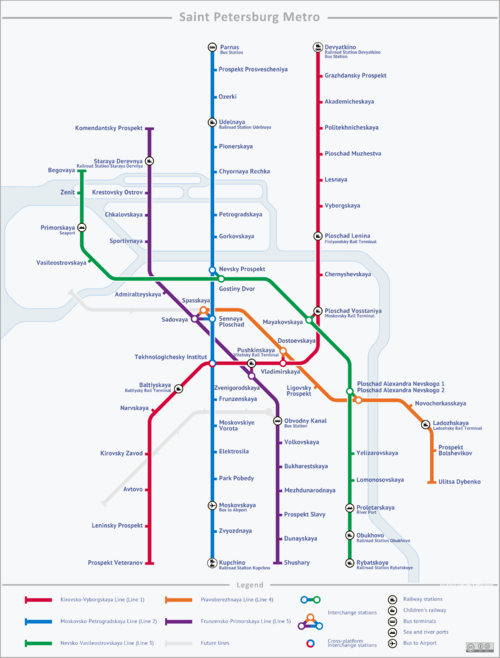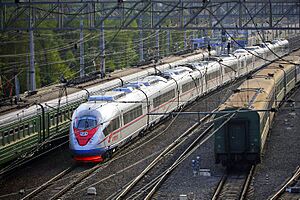Saint Petersburg facts for kids
Quick facts for kids
Saint Petersburg
Санкт-Петербург
|
|||
|---|---|---|---|
|
Federal city
|
|||
|
Clockwise from top: the Winter Palace; Peter and Paul Cathedral; the General Staff Building; the Moyka River from the Pevchesky Bridge to the Red Bridge; Saint Isaac's Cathedral; and Palace Bridge
|
|||
|
|||
| Anthem: "Anthem of Saint Petersburg" |
|||

Location of Saint Petersburg in European Russia
|
|||
| Country | Russia | ||
| Federal district | Northwestern | ||
| Economic region | Northwestern | ||
| Founded | 27 May 1703 | ||
| City raions | See list | ||
| Government | |||
| • Body | Legislative Assembly | ||
| Area | |||
| • Federal city | 1,439 km2 (556 sq mi) | ||
| Elevation | 3 m (10 ft) | ||
| Population
(2021)
|
|||
| • Federal city | |||
| • Rank | 4th in Europe 2nd in Russia |
||
| • Density | 3,992.81/km2 (10,341.3/sq mi) | ||
| • Metro | |||
| Demonym(s) | Petersburgian | ||
| GDP | |||
| • Federal city | ₽ 11.166 trillion (US$ 160 billion) (2022) |
||
| • Per capita | ₽ 1,992,592 (US$ 28508) (2022) |
||
| Time zone | UTC+3 (MSK) | ||
| Postal code |
190000—199406
|
||
| Area code | 812 | ||
| ISO 3166 code | RU-SPE | ||
| Vehicle registration | 78, 98, 178, 198 | ||
| OKATO ID | 40 | ||
| OKTMO ID | 40000000 | ||
| Official language | Russian | ||
Saint Petersburg is a big city in Russia. It is the second largest city in Russia, after Moscow. The city is located on the River Neva, where it meets the Gulf of Finland and the Baltic Sea. In 2021, over 5.6 million people lived here. If you count the wider area, more than 6.4 million people call Saint Petersburg home. It is the fourth most populated city in Europe. It is also the biggest city on the Baltic Sea. Saint Petersburg is the world's northernmost city with over 1 million people. It used to be the capital of Imperial Russia. Today, it is a special "federal city" within Russia.
The city was started by Tsar Peter the Great on May 27, 1703. He built it on the site of a Swedish fortress he had captured. He named it after Saint Peter. In Russia, Saint Petersburg is linked to the start of the Russian Empire. It helped Russia become a modern European power. It was the capital from 1712 to 1918. After the October Revolution in 1917, the government moved back to Moscow. The city was renamed Leningrad after Lenin died in 1924. During World War II, it faced a very long and deadly attack called the siege of Leningrad. In 1991, people voted to change the city's name back to Saint Petersburg.
Saint Petersburg is Russia's cultural heart. In 2018, over 15 million tourists visited. It is a key place for business, science, and tourism in Russia and Europe. People often call it "the Northern Capital of Russia." It is home to important government offices, like the Constitutional Court of Russia. The Historic Centre of Saint Petersburg and Related Groups of Monuments is a UNESCO World Heritage Site. The city has the Hermitage Museum, one of the world's largest art museums. It also has the Lakhta Center, which is the tallest skyscraper in Europe. Saint Petersburg was a host city for the 2018 FIFA World Cup and UEFA Euro 2020.
Contents
- Understanding the City's Names
- A Look at Saint Petersburg's Past
- Saint Petersburg's Geography
- People of Saint Petersburg
- Saint Petersburg's Economy
- Cityscape and Landmarks
- Tourism in Saint Petersburg
- Education in Saint Petersburg
- Sports in the City
- Transportation in Saint Petersburg
- Images for kids
- See also
Understanding the City's Names
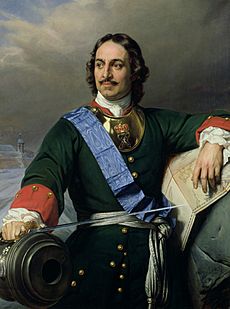
The city was named after Saint Peter. This was because Peter the Great started building the Peter and Paul Fortress and a church named after Saint Peter and Saint Paul in June 1703. Peter the Great used different spellings for the city's name. The name later became standardized as Санкт-Петербург (Sankt-Peterburg).
Over time, people used shorter names for the city. One common nickname is Piter (Питер).
How the City's Name Changed Over Time
In the 1830s, the poet Alexander Pushkin used the name Petrograd. This name sounded more Russian than "Saint Petersburg." On August 31, 1914, during World War I, Tsar Nicholas II officially changed the city's name to Petrograd. This was to remove the German words "Sankt" and "Burg" from the name.
On January 26, 1924, after Vladimir Lenin died, the city was renamed Leningrad. This means 'Lenin City'. Many streets were also renamed to honor communist figures.
On September 6, 1991, the city's original name, Sankt-Peterburg, was brought back. This happened after people voted in a city-wide referendum. Even today, the region around the city is still called Leningrad Oblast.
Saint Petersburg is often called the "Window to Europe" or "Window to the West." This is because it helped Russia connect with Europe. The city is also known as the "Venice of the North." This is due to its many canals and bridges. It has European-style buildings mixed with Russian culture. Another nickname is "The City of the White Nights." This is because in summer, the sky does not get completely dark for about a month. This happens because the city is close to the polar region.
A Look at Saint Petersburg's Past
The Imperial Era (1703–1917)
Before Saint Petersburg was built, there was a Swedish fort called Nyenskans. This area was home to different groups of people, including Finns and Russians.
In the late 1600s, Peter the Great wanted Russia to have a seaport. This port would help Russia trade with Europe. The old port in Arkhangelsk was too far north and froze in winter. So, Peter needed a better one.
On May 27, 1703, during the Great Northern War, Peter the Great captured the Swedish fort. He then started building the Peter and Paul Fortress on Zayachy Island. This was the first stone building of the new city.
The city was built by peasants who were forced to work. Many thousands of them died during construction. In 1712, Peter moved Russia's capital from Moscow to Saint Petersburg. He lived in a small log cabin while the city was being built.
Early on, the city grew around Trinity Square. Later, it was planned out with a grid of canals. Famous architects like Domenico Trezzini and Jean-Baptiste Alexandre Le Blond helped design the city. Buildings like the Menshikov Palace show the early "Petrine Baroque" style. In 1724, Peter the Great also started the Academy of Sciences and a university here.
Peter the Great died in 1725. For a short time, the capital moved back to Moscow. But in 1732, under Empress Anna of Russia, Saint Petersburg became the capital again. It remained the seat of the Romanov royal family and the Russian government for 186 more years.
Fires in 1736–1737 damaged the city. A new plan was made, and the city center moved to the Admiralty area. Three main streets, including Nevsky Prospect, spread out from the Admiralty building. The Baroque architecture style was popular, with buildings like the Winter Palace. Later, neoclassical architecture became popular.
In the 1760s, the banks of the Neva River were lined with granite. The first permanent bridge across the Neva, Annunciation Bridge, opened in 1850.
Many famous buildings were designed by architects like Francesco Bartolomeo Rastrelli (Winter Palace), Giacomo Quarenghi (Academy of Sciences), Andrey Voronikhin (Kazan Cathedral), Carlo Rossi (General Staff Building), and Auguste de Montferrand (Saint Isaac's Cathedral).
In 1810, the first engineering university was founded here. Many monuments celebrate Russia's victory over Napoleon in 1812, like the Alexander Column. In 1825, a revolt against Tsar Nicholas I happened in the city.
By the 1840s, new architectural styles appeared. After the serfs were freed in 1861, many peasants moved to the capital. Saint Petersburg grew into a large industrial city. It had a big naval base in Kronstadt.
Some Russian emperors were assassinated in Saint Petersburg. Alexander II was killed by terrorists in 1881. The 1905 Russian Revolution also started in Saint Petersburg.
On September 1, 1914, at the start of World War I, the city was renamed Petrograd. This was to remove German words from its name.
Revolution and the Soviet Era (1917–1941)
In March 1917, Tsar Nicholas II gave up his throne. This ended the Russian monarchy. On November 7, 1917, the Bolsheviks, led by Vladimir Lenin, took control of the Winter Palace. This event was called the October Revolution. It led to the rise of the Communist Party. The city then became known as "the city of three revolutions."
On March 12, 1918, Lenin moved the government back to Moscow. This was to keep it safe from German forces during the Russian Civil War. In 1919, anti-communist forces tried to capture the city but were stopped.
On January 26, 1924, after Lenin's death, Petrograd was renamed Leningrad. Many streets were renamed to honor communist figures. The city has over 230 places linked to Lenin. Some became museums, like the cruiser Aurora, a symbol of the October Revolution.
In the 1920s and 1930s, new neighborhoods were built. Many "bourgeois" apartments were turned into "communal" apartments where several families lived together. In 1935, a new plan was made to expand the city to the south.
During the Soviet era, some old buildings, especially churches, were destroyed for political reasons. On December 1, 1934, Sergey Kirov, a leader in Leningrad, was killed. This event led to the Great Purge, where many people were executed. In Leningrad, about 40,000 people were killed during these purges.
World War II (1941–1945)

During World War II, German forces surrounded Leningrad. This was called the Siege of Leningrad. It lasted for 872 days, from September 8, 1941, to January 27, 1944.
The Siege of Leningrad was one of the longest and deadliest sieges in history. The city was cut off from food supplies. Food could only come through the "Road of Life" across Lake Ladoga when it froze. More than one million people died, mostly from starvation. Many others left or were moved out.
On May 1, 1945, Joseph Stalin named Leningrad a "hero city" for its brave resistance. In 1965, Leningrad received the Order of Lenin and the Gold Star medal for its heroic defense.
After the War (1945–1991)
After the war, Leningrad and its suburbs were rebuilt. Some areas from Finland were added to the city. The Leningrad Metro opened in 1955. Its stations were beautifully decorated.
After Stalin died in 1953, the fancy style of buildings was stopped. From the 1960s to the 1980s, many new apartment buildings were built on the city's edges. Many families moved from shared "communal" apartments to their own homes.
Leningrad was involved in a political event called the "Leningrad Affair" (1949–1952). Many city leaders were removed or punished.
Modern Times (1991–Present)
On June 12, 1991, people voted to bring back the city's original name, Saint Petersburg. Anatoly Sobchak became the first elected mayor.
The economy faced difficulties in the 1990s. Food rationing was introduced, and the city received food aid from other countries. Economic conditions started to get better in the early 2000s.
In 1996, Vladimir Yakovlev became the city's head, now called "governor." Building activity increased, and real estate prices went up. This caused problems for preserving the historic parts of the city.
The city center is a UNESCO site with about 8,000 historic buildings. However, some older buildings were allowed to be torn down after 2005. There was a plan to build a very tall skyscraper, the Okhta Center, near a historic area. Many people protested this. In 2010, the plan was changed. The skyscraper, now called Lakhta Center, was built in a different area, Lakhta. It was finished in 2019 and is now the tallest building in Russia and Europe.
Saint Petersburg's Geography
Saint Petersburg covers about 605.8 square kilometers. The wider federal area is 1439 square kilometers. This area includes the city itself, nine towns, and twenty-one settlements.
Petersburg is on lowlands along the Neva Bay of the Gulf of Finland. It is built on islands in the river delta. The largest islands are Vasilyevsky Island, Petrogradsky, Dekabristov, and Krestovsky. The Karelian Isthmus to the north is a popular vacation spot.
The city's elevation ranges from sea level to 175.9 meters at Orekhovaya Hill. Parts of the city are very low, only 4 meters above sea level. This means the city has suffered from many floods. Floods happen when strong winds push water from the Baltic Sea into the Neva Bay. To stop floods, the Saint Petersburg Dam was built.
Over the years, parts of the city's land have been raised artificially. This has changed the city's water system. Besides the Neva, other important rivers are the Sestra, Okhta, and Izhora. The largest lake is Sestroretsky Razliv.
Because it is so far north (around 60° N latitude), the length of daylight changes a lot. In summer, from mid-May to mid-July, the sky stays light all night. This is called the white nights.
Saint Petersburg is about 165 kilometers from the border with Finland.
Saint Petersburg's Climate
Saint Petersburg has a humid continental climate. The Baltic Sea makes the weather milder. Summers are mild to hot, humid, and short. Winters are long, moderately cold, and wet. The climate is similar to Helsinki's.
The average high temperature in July is 23°C. The average low in February is -8.5°C. The highest temperature ever recorded was 37.1°C in 2010. The lowest was -35.9°C in 1883. The Neva River usually freezes in November–December and thaws in April. Snow covers the ground for about 118 days a year.
The city gets about 660 mm of rain each year, mostly in late summer. The air is often humid, around 78%. There are about 165 cloudy days per year.
| Climate data for Saint Petersburg (1991–2020, extremes 1743–present) | |||||||||||||
|---|---|---|---|---|---|---|---|---|---|---|---|---|---|
| Month | Jan | Feb | Mar | Apr | May | Jun | Jul | Aug | Sep | Oct | Nov | Dec | Year |
| Record high °C (°F) | 8.7 (47.7) |
10.2 (50.4) |
15.3 (59.5) |
25.3 (77.5) |
33.0 (91.4) |
35.9 (96.6) |
35.3 (95.5) |
37.1 (98.8) |
30.4 (86.7) |
21.0 (69.8) |
12.3 (54.1) |
10.9 (51.6) |
37.1 (98.8) |
| Mean daily maximum °C (°F) | −2.5 (27.5) |
−2.4 (27.7) |
2.3 (36.1) |
9.5 (49.1) |
16.3 (61.3) |
20.5 (68.9) |
23.3 (73.9) |
21.4 (70.5) |
15.9 (60.6) |
8.7 (47.7) |
2.8 (37.0) |
−0.5 (31.1) |
9.6 (49.3) |
| Daily mean °C (°F) | −4.8 (23.4) |
−5.0 (23.0) |
−1.0 (30.2) |
5.2 (41.4) |
11.5 (52.7) |
16.1 (61.0) |
19.1 (66.4) |
17.4 (63.3) |
12.4 (54.3) |
6.2 (43.2) |
0.9 (33.6) |
−2.5 (27.5) |
6.3 (43.3) |
| Mean daily minimum °C (°F) | −7.2 (19.0) |
−7.6 (18.3) |
−4.0 (24.8) |
1.7 (35.1) |
7.2 (45.0) |
12.2 (54.0) |
15.3 (59.5) |
13.9 (57.0) |
9.4 (48.9) |
4.1 (39.4) |
−0.9 (30.4) |
−4.5 (23.9) |
3.3 (37.9) |
| Record low °C (°F) | −35.9 (−32.6) |
−35.2 (−31.4) |
−29.9 (−21.8) |
−21.8 (−7.2) |
−6.6 (20.1) |
0.1 (32.2) |
4.9 (40.8) |
1.3 (34.3) |
−3.1 (26.4) |
−12.9 (8.8) |
−22.2 (−8.0) |
−34.4 (−29.9) |
−35.9 (−32.6) |
| Average precipitation mm (inches) | 46 (1.8) |
36 (1.4) |
36 (1.4) |
37 (1.5) |
47 (1.9) |
69 (2.7) |
84 (3.3) |
87 (3.4) |
57 (2.2) |
64 (2.5) |
56 (2.2) |
51 (2.0) |
670 (26.4) |
| Average extreme snow depth cm (inches) | 15 (5.9) |
19 (7.5) |
14 (5.5) |
1 (0.4) |
0 (0) |
0 (0) |
0 (0) |
0 (0) |
0 (0) |
0 (0) |
3 (1.2) |
9 (3.5) |
19 (7.5) |
| Average rainy days | 9 | 7 | 10 | 13 | 16 | 18 | 17 | 17 | 20 | 20 | 16 | 10 | 173 |
| Average snowy days | 25 | 23 | 16 | 8 | 1 | 0.1 | 0 | 0 | 0.1 | 5 | 16 | 23 | 117 |
| Average relative humidity (%) | 86 | 84 | 79 | 69 | 65 | 69 | 71 | 76 | 80 | 83 | 86 | 87 | 78 |
| Mean monthly sunshine hours | 18.9 | 45.5 | 120.5 | 177.9 | 255.6 | 254.3 | 267.7 | 228.1 | 134.8 | 61.8 | 23.0 | 8.1 | 1,596.2 |
| Source 1: Pogoda.ru.net | |||||||||||||
| Source 2: NOAA | |||||||||||||
People of Saint Petersburg
Saint Petersburg is the second largest city in Russia. In 2021, its population was 5,601,911. This is about 3.9% of Russia's total population. The wider metropolitan area has over 6.4 million people.
| Historical population | ||
|---|---|---|
| Year | Pop. | ±% p.a. |
| 1897 | 1,264,920 | — |
| 1926 | 1,590,770 | +0.79% |
| 1939 | 3,191,304 | +5.50% |
| 1959 | 3,321,196 | +0.20% |
| 1970 | 3,949,501 | +1.59% |
| 1979 | 4,588,183 | +1.68% |
| 1989 | 5,023,506 | +0.91% |
| 2002 | 4,661,219 | −0.57% |
| 2010 | 4,879,566 | +0.57% |
| 2021 | 5,601,911 | +1.26% |
| Source: Census data | ||
Births and Deaths (2022):
- Births: 50,663 (9.4 per 1,000 people)
- Deaths: 65,137 (12.1 per 1,000 people)
Life Expectancy (2021):
- Total: 72.51 years (males: 68.23, females: 76.30)
Ethnic Groups in Saint Petersburg
The city's population has changed a lot over the 20th century. In 1916, it had 2.4 million people. By 1920, after the Revolution and Russian Civil War, it dropped to under 740,000. Many minority groups were moved out in the 1930s. During the Siege of Leningrad (1941-1943), the population fell from 3 million to under 600,000. Many died from starvation or were moved away.
After the siege, some people returned, and many others moved in from other parts of the Soviet Union. The city grew to over 5 million people in the 1980s. From 1991 to 2006, the population decreased to 4.6 million. But by 2010, it was over 4.8 million, and by 2021, it reached 5.6 million.
Religion in the City
Most people in Saint Petersburg believe in God. The majority are Orthodox Christians (57.5%). There are also smaller groups of Muslims (0.7%), Protestants (0.6%), Catholics (0.5%), and Buddhists (0.1%).
About 59% of the city's population is Christian. Over 90% of these Christians are Orthodox.
There are 268 religious groups in the city. The Russian Orthodox Church has 130 groups. Other groups include Pentecostals, Lutherans, Baptists, Old Believers, Catholics, Armenians, Adventists, Jews, Buddhists, and Muslims.
Many religious buildings are owned or used by these groups. The oldest cathedral is the Peter and Paul Cathedral, built from 1712 to 1733. The largest is the Kazan Cathedral, finished in 1811.
Saint Petersburg's Economy
Saint Petersburg is a big center for trade, finance, and industry in Russia. It specializes in:
- Oil and gas trade
- Shipbuilding
- Aerospace industry
- Technology (like electronics and software)
- Machine building (including military equipment)
- Mining
- Chemicals and pharmaceuticals
- Publishing and printing
- Food and clothing industries
Major local companies include Admiralty Shipyard, Baltic Shipyard, and Kirov Plant. The Port of Saint Petersburg has three large cargo terminals. International cruise liners also use the passenger port. The city's riverports connect to seaports, making Saint Petersburg a key link between the Baltic Sea and the rest of Russia through the Volga–Baltic Waterway.
The Saint Petersburg Mint, founded in 1724, is one of the world's largest mints. It makes Russian coins, medals, and badges.
Many car companies, like Toyota, Opel, Hyundai, and Nissan, have built plants in Saint Petersburg. The car industry has grown a lot here.
Saint Petersburg is known as Russia's "beer capital." Its five large breweries make over 30% of the country's beer. These include Baltika, Europe's second-largest brewery. The city also has many distilleries that make different vodka brands.
The city has the second largest construction industry in Russia. This includes building homes, businesses, and roads.
In 2016, Saint Petersburg's economy was the second largest among all Russian regions, after Moscow.
Cityscape and Landmarks
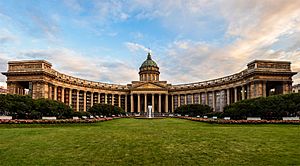
The historic buildings in Saint Petersburg's city center are mostly from the 18th and 19th centuries. They are in Baroque and Neoclassical styles. Many have been kept in their original form. The oldest building is a wooden house built for Peter I in 1703. Since 1991, the Historic Centre of Saint Petersburg and Related Groups of Monuments has been a UNESCO World Heritage Site.
The Peter and Paul Fortress with its cathedral stands on Zayachy Island. A cannon fires a blank shot from the fortress every noon. Nearby is the Saint Petersburg Mosque, which was the largest mosque in Europe when it opened in 1913.
The Spit of Vasilievsky Island divides the Neva River into two large branches. It has the Old Saint Petersburg Stock Exchange and Rostral Columns. The south side of Vasilyevsky Island has some of the city's oldest buildings, like the Kunstkamera and Menshikov Palace. It is also home to Saint Petersburg State University.
On the south bank of the Neva, you'll find the Admiralty building. There is also the huge Hermitage Museum complex, which includes the Winter Palace. The Winter Palace faces Palace Square, the city's main square, with the Alexander Column.
Nevsky Prospekt is the city's main street. It starts at the Admiralty and goes east. Many famous buildings are along this street, including the Kazan Cathedral and the Alexandrine Theatre. It ends at the Alexander Nevsky Lavra, an important Christian center.
Between the Neva River and Nevsky Prospekt, you can find the Church of the Savior on Blood, the Russian Museum, the Field of Mars, and the Smolny Institute.
West and south of the Admiralty Building are other landmarks. These include the Mariinsky Theatre, Saint Isaac's Cathedral (the largest in the city), and Senate Square. On Senate Square, you'll see the Bronze Horseman, a famous statue of Peter the Great.
Other symbols of Saint Petersburg are the small ship on top of the Admiralty's golden spire and the golden angel on the Peter and Paul Cathedral. The Palace Bridge opening at night is also a famous sight.
From April to November, 22 bridges across the Neva and main canals open up at night. This lets ships pass through. The city has hundreds of smaller bridges over its many canals. Because of these canals, Saint Petersburg is often called Venice of the North. The riverbanks are lined with granite.

The southern suburbs have former imperial homes. These include Petergof, with its beautiful fountains and parks. Tsarskoe Selo has the Catherine Palace and Alexander Palace. Pavlovsk has a palace and one of Europe's largest English-style parks. Kronstadt, with its old forts and naval monuments, is on Kotlin Island in the Gulf of Finland.
Many old buildings in the city center have been restored or rebuilt recently.
City Parks and Gardens
Saint Petersburg has many parks and gardens. Some of the most famous are in the southern suburbs, like Pavlovsk Park. Sosnovka is the largest park within the city, covering 240 hectares. The Summer Garden is the oldest, from the early 1700s. It is known for its iron railing and marble statues.
Other notable parks include the Maritime Victory Park and the Moscow Victory Park. Both celebrate the victory in World War II. The Central Park of Culture and Leisure is on Yelagin Island. Common trees in the parks include oak, maple, birch, and pine.
For the city's 300th anniversary, a new park was created in the northwest. It has 300 valuable trees and other plants. These trees were given by various organizations and sister cities.
Tall Buildings in the City
Rules in Saint Petersburg prevent very tall buildings in the city center. Until the early 2010s, only three skyscrapers were built outside the historic center: Leader Tower (140 m), Alexander Nevsky (124 m), and Atlantic City (105 m). The Saint Petersburg TV Tower, built in 1962, was the tallest structure at 310 meters.
A plan to build a 396-meter skyscraper, the Okhta Center, near the historic Smolny area caused concern. The World Monuments Fund worried it would change the city's unique skyline. The project was canceled in 2010.
In 2012, the Lakhta Center project began in the city's outskirts. It includes a 463-meter tall office skyscraper. This project caused less controversy because it was far from the historic center. The skyscraper was finished in 2019. At 462.5 meters, it is now the tallest building in Russia and Europe.
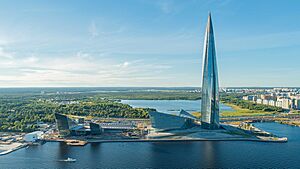
Tourism in Saint Petersburg
| UNESCO World Heritage Site | |
|---|---|
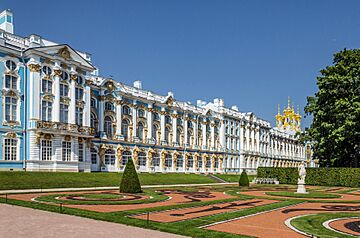
|
|
| Official name | Historic Centre of Saint Petersburg and Related Groups of Monuments |
| Criteria | Cultural: (i), (ii), (iv), (vi) |
| Inscription | 1990 (14th Session) |
| Extensions | 2013 |
| Area | 3,934.1 ha (15.190 sq mi) |
Saint Petersburg has a rich history and culture. Its 18th and 19th-century buildings are well preserved. Unlike many other European cities, Saint Petersburg kept much of its old architecture. This is partly because it lost its capital status, so new, modern buildings were often built in Moscow instead.
Saint Petersburg is a UNESCO World Heritage site. It has 36 historic architectural complexes and about 4,000 important individual monuments. Many new tours help visitors explore the city's cultural heritage.
The city has 221 museums, 2,000 libraries, over 80 theaters, and 100 concert halls. It also has 45 galleries and 62 cinemas. Each year, it hosts about 100 festivals and art competitions.
Even during tough economic times in the 1990s, no major theaters or museums closed. In fact, many new ones opened. For example, a private puppet museum opened in 1999. The city's museums are very diverse. Besides the famous Hermitage Museum and Russian Museum, there are palace museums, small town museums, and museums about famous writers like Dostoyevsky.
Saint Petersburg has a vibrant musical life. Ballet performances are very important. The Petersburg School of Ballet is known as one of the best in the world. Famous dancers like Rudolf Nureyev and Mikhail Baryshnikov came from here.
The first music school, the Saint Petersburg Conservatory, was founded in 1862. Famous composers like Pyotr Tchaikovsky and Dmitri Shostakovich studied or taught there. Shostakovich dedicated his Seventh Symphony to the city. He wrote it during the siege of Leningrad.
The Leningrad Philharmonic Orchestra became one of the world's best under conductor Yevgeny Mravinsky.
Saint Petersburg has also been a center for new popular music. Early jazz bands formed here. In the 1960s, student rock groups started underground concerts. In 1972, Boris Grebenshchikov formed the band Aquarium, which became very popular. This led to the "Peter's rock" music style.
Today, Saint Petersburg has many famous musicians in different genres. The White Nights Festival is known for its fireworks and shows celebrating the end of the school year. The band Little Big is also from Saint Petersburg.
Literature of Saint Petersburg
Saint Petersburg has a long and famous history in literature. Writers like Dostoyevsky saw it as an "abstract and intentional city." It often appeared as a dark and unfriendly place in Russian stories. This image is seen in the poems of Alexander Pushkin, the stories of Gogol, and the novels of Dostoyevsky. These writers were inspired by the city itself. The struggles of poor clerks in a society focused on status also became a key theme. Early Saint Petersburg literature also included myths and ghost stories, making the city seem surreal.
20th-century writers from Saint Petersburg, like Vladimir Nabokov and Ayn Rand, created new styles of writing. Anna Akhmatova was an important poet. Her poem Requiem described the dangers during the Stalin era. Another famous writer from Saint Petersburg is Joseph Brodsky, who won the Nobel Prize in Literature.
Film in the City
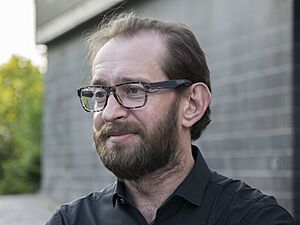
Over 250 international and Russian movies have been filmed in Saint Petersburg. The first film studios were founded here in the 20th century. Since the 1920s, Lenfilm has been the largest film studio in the city. The 1997 film Anna Karenina was the first foreign movie filmed entirely in Saint Petersburg.
The comedy Irony of Fate is set in Saint Petersburg. The 1985 film White Nights showed real Leningrad street scenes. Other movies filmed here include GoldenEye (1995) and Brother (1997). The Russian romantic comedy Piter FM also features the city's scenery.
Several international film festivals happen every year, like the Festival of Festivals, Saint Petersburg.
Dramatic Theatre
Saint Petersburg has many dramatic theaters and drama schools. These include the Student Theatre on Mokhovaya Street, Leteiny Theatre, and Youth Theatre on the Fontanka.
Education in Saint Petersburg
As of 2006–2007, Saint Petersburg had 1,024 kindergartens, 716 public schools, and 80 vocational schools. The largest public university is Saint Petersburg State University, with about 32,000 students. The largest private university is the Institute of International Economic Relations, Economics, and Law. Other well-known universities include Saint Petersburg Polytechnic University and Herzen University. All public universities are owned by the federal government, not the city.
Sports in the City

Leningrad hosted some football games during the 1980 Summer Olympics. The 1994 Goodwill Games were also held here.
Boating has a long history in the city, starting with Peter the Great in 1703. The Russian Navy has held Yachting events since the city's founding. In winter, people sail ice boats on the frozen water.
Equestrianism (horse riding) has also been a tradition, popular with the Tsars and military. Several old sports arenas were built for horse riding training.
Chess is important here. In 1914, a tournament in Saint Petersburg first formally gave the title "Grandmaster" to five players.
The city's main football team is FC Zenit Saint Petersburg. They have won the Russian league nine times and the Russian Cup five times. They also won the 2007–08 UEFA Cup and the 2008 UEFA Super Cup. Their home stadium is Gazprom Arena, which opened in 2017. This stadium hosted games for the 2017 FIFA Confederations Cup, 2018 FIFA World Cup, and UEFA Euro 2020.
Hockey teams include SKA Saint Petersburg in the KHL. SKA Saint Petersburg is very popular and has won the Gagarin Cup twice. Famous players like Pavel Datsyuk and Ilya Kovalchuk have played for them. They play at SKA Arena.
The city's basketball team is BC Spartak Saint Petersburg. They won two championships in the USSR Premier League. Famous players like Alexander Belov played for them. BC Zenit Saint Petersburg also plays in the city.
Transportation in Saint Petersburg
Saint Petersburg is a major transport hub. The first Russian railway was built here in 1837. The city has a large public transport system, including buses, trams, and trolleybuses. It also has a metro system and river services.
The city is connected to the rest of Russia and the world by highways and railways. Pulkovo Airport serves most air travelers.
Public Transport Options

Saint Petersburg has a big public transport network. This includes buses, trams, and trolleybuses. In 2022, most marshrutkas (minibuses) were replaced by public buses. Trams used to be the main way to get around, and in the 1980s, Saint Petersburg had the largest tram network in the world.
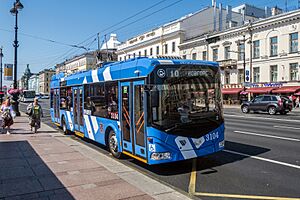
Buses carry up to three million people daily. The Saint Petersburg Metro opened in 1955. It has 5 lines and 72 stations, connecting all five railway terminals. It carries 2.3 million passengers daily. Metro stations are often beautifully decorated with marble and bronze.
New metro stations have opened or are planned, including Prospekt Slavy, Dunayskaya, and Shushary. Novokrestovskaya station was built for the 2018 FIFA World Cup.
| Saint Petersburg Metro map |
|---|
Roads and Highways
Traffic jams are common in the city. This is due to daily commuters, intercity traffic, and heavy winter snow. New freeways like the Saint Petersburg Ring Road (finished in 2011) and the Western High-Speed Diameter (finished in 2017) have helped reduce traffic. The M11 Neva connects Saint Petersburg to Moscow.
Saint Petersburg is an important route linking Scandinavia to Russia and Eastern Europe. It is part of international European routes like European route E18 (to Helsinki) and European route E105 (to Moscow).
Water Travel
The city has passenger and cargo seaports in the Neva Bay of the Gulf of Finland. There are also river ports on the Neva River. Saint Petersburg is the end point for the Volga–Baltic Waterway and White Sea–Baltic waterways.
The Big Obukhovsky Bridge, opened in 2004, is the first high bridge over the Neva that does not need to open for ships. Hydrofoil boats connect the city center to coastal towns like Kronstadt from May to October. In warmer months, many smaller boats and water taxis travel on the city's canals.
The shipping company St. Peter Line runs ferries from Helsinki and Stockholm to Saint Petersburg.
Rail Travel
Saint Petersburg is the destination for many intercity and suburban railways. It has five main railway terminals: Baltiysky, Finlyandsky, Ladozhsky, Moskovsky, and Vitebsky.
Saint Petersburg has international train connections to Helsinki, Finland, and Berlin, Germany. The Helsinki railway, built in 1870, is 443 km long. Until 2022, trains ran five times a day, taking about three and a half hours.
The Moscow–Saint Petersburg Railway opened in 1851 and is 651 km long. The trip to Moscow takes from three and a half to nine hours.
In 2009, Russian Railways started a high-speed service called Sapsan between Moscow and Saint Petersburg. This train can travel very fast, setting records for the fastest train in Russia.
From 2010 to 2022, "Allegro" trains ran high-speed services between Saint Petersburg and Helsinki. This service has been stopped.
| Intercity and suburban rail terminals of St. Petersburg |
|---|
Air Travel
Saint Petersburg is served by Pulkovo International Airport.
Pulkovo airport opened in 1931. As of 2013, it is the 3rd busiest airport in Russia. It handles over 12 million passengers each year. The airport has been greatly modernized. A new Terminal 1 opened in 2013 for international flights. The renovated Pulkovo-1 terminal opened in 2015 for domestic flights. Rossiya, one of Russia's oldest airlines, is based at Pulkovo Airport.
There are regular buses and taxis connecting Pulkovo airport to the Moskovskaya metro station.
Images for kids
See also
 In Spanish: San Petersburgo para niños
In Spanish: San Petersburgo para niños


